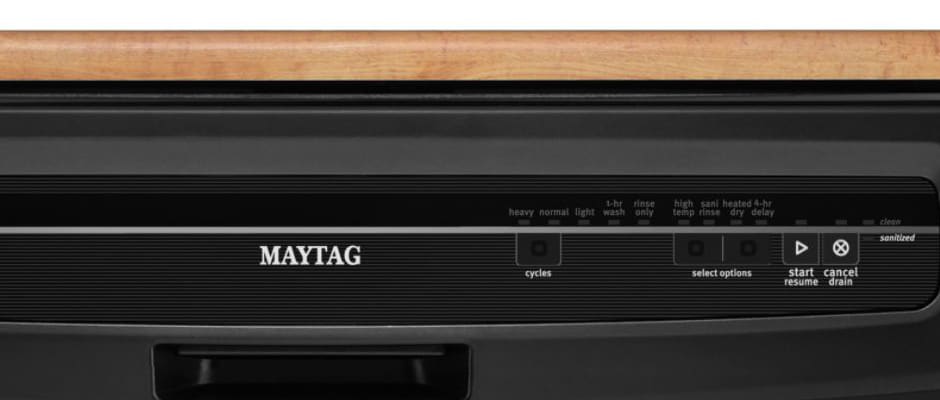Introduction
Design & Usability
{{section_header}}{{section.name}}{{/section_header}}
Like any good portable dishwasher, this model is functional and intuitive; don't expect it to win any beauty contests, though.
Since the term "portable" can be indicative of a fair amount of movement, the {{product.model}} is surprisingly sturdy. While the black exterior is highly reflective, the unassuming design should make this model a decent fit for a wide range of kitchens—so long as you don't mind the shiny, fake butcher block top. There are also detachable wheel casters for easy maneuverability. The best part is that all three of the main connection devices (drain hose, power cord, water intake) are already hooked up and merely need to be attached to a sink and power supply. As far as the control panel, we have to wonder: Why use multiple buttons to scroll through a mere four options?
The plastic white interior contrasts with the black exterior. While the plastic feels somewhat cheap, it doesn’t seem to impinge on the machine’s overall cleaning power, though it doesn't mask any of the sound this already noisy machine makes. The lower rack slides easily enough, and the vinyl coating ensured dishes stayed firmly in place. The upper rack is not adjustable, but it is well laid out and created a considerable amount of space. Our one (minor) complaint was that the two rows of tines were angled in such a way as to limit space along the perimeter of the rack.
{{photo_gallery "Front Closed Photo", "Fingerprints Photo", "Controls 1 Photo", "Controls 2 Photo", "Front Open Photo", "Interior Detail Photo", "Top Rack Photo", "Top Rack Detail Photo 1", "Top Rack Detail Photo 2", "Top Rack Detail Photo 3", "Bottom Rack Photo", "Bottom Rack Detail Photo 2", "Bottom Rack Detail Photo 3", "Cutlery Basket Photo", "Cutlery Basket Detail Photo 1", "Cutlery Basket Detail Photo 2", "Cutlery Basket Detail Photo 3"}}
Features
{{section_header}}{{section.name}}{{/section_header}}
Consumers looking for a little versatility from their dishwasher won’t be disappointed, but it doesn't go above and beyond to impress.
The three main cycles—Light, Normal, and Heavy—in addition to the 1-Hour Wash (the quick cycle) should satisfy most washing needs. Three features can be added to individual cycles: a high-temperature rinse, a sanitize wash, and a heated dry option. We tested the sanitize feature and found it was able to reach a sufficiently high wash temperature of 156ºF. In addition, there's a four-hour delay feature, as well as a display that indicates when a cycle is cleaned and/or sanitized.
Performance
{{section_header}}{{section.name}}{{/section_header}}
The fact that it's portable is important, but the performance just doesn't justify the expensive price tag.
Everything about the {{product.model}} was just… meh. The 1-Hour Wash, for instance, was decent—when scaled against regular expectations, it actually did better than all the other cycles—but nothing was ever really cleaned to perfection. All of the cycles had trouble with our tea stain—a test that comes out perfectly on a vast majority of the machines we've seen—and the Normal cycle was disappointingly inconsistent. That said, the Heavy Duty cycle did surprisingly well...at least, compared to other machines in its class.
No matter what, this machine is cleaning better and more efficiently than any hand washing you try in the sink. If you can't install a built-in, buy this instead.
Conclusion
{{section_header}}{{section.name}}{{/section_header}}
Could be great for consumers living with leases that restrict renovations or for those who move a lot, but it's just too darn expensive.
The portable {{product.name}} would be a solid dishwasher for the $300-$500 price range, but it’s considerably more expensive than that (MSRP: $749.00). There’s nothing atrocious about this machine’s performance, efficiency, usability, or features—it's just the premium you pay for a portable machine. That said, it's also worth noting that a portable machine like this precludes the need for any extensive kitchen renovation, and can be an easy addition to apartments where you're not allowed to do any construction. It's also a lot more efficient and effective than hand washing.
Science Introduction
{{section_header}}{{section.name}}{{/section_header}}
For a cheaper portable machine, we'd probably have been satisfied with the results of our tests. As it is, the high price tag raises our standards and, consequently, our disappoint with this {{product.brand.name}}.
Performance
{{section_header}}{{section.name}}{{/section_header}}
Less than what we'd like to see
Surprisingly, each of the wash cycles had trouble with our tea stain. It's usually one of our easiest tests, created by drying an English breakfast tea bag to the bottom of a mug. Even more surprising is that it did well in most other categories. Still, spinach and milk proved difficult for the Normal cycle, and there was a notable degree of inconsistency across multiple runs. The quick 1-Hour Wash was pretty decent, but it still had trouble with our spinach, milk, and tea stains, and nothing came out completely clean.
The Heavy Cycle did surprisingly well on our baked lasagna test, and it saw considerable improvement in our protein tests (milk, meat, and egg) compared to other cycles. For some reason, though, it still had trouble with our tea stains. The cycle speeds were pretty average: the 1-Hour Wash, not surprisingly, took an hour to complete (62 minutes, to be exact), while the Normal and Heavy cycles took 96 and 134 minutes, respectively.
{{photo_gallery "Science Section 1 Images"}}
Efficiency
{{section_header}}{{section.name}}{{/section_header}}
While it doesn’t blow its competitors out of the water, it’s not likely to make a huge mark on your utility bills.
We found the {{product.model}} used between 0.6 and 1.07 kWh per cycle. A fairly average finding, this translates to electricity costs of roughly 6 to 11 cents per wash. Water consumption was slightly higher, depending on the chosen cycle. Since it hooks up directly to a faucet, the level of efficiency also depends on how hot you run your tap during operation. While the Normal wash’s 3.91 gallons is pretty impressive for a standard cycle, the 1-Hour Wash used a slightly above-average 5.02. Including the Heavy wash’s consumption of 7.02 gallons, these figures averaged out to a water bill of about 4 to 7 cents per cycle. Averaged through the course of a year—with the Normal cycle used 50 percent of the time—we found the {{product.name}} will cost roughly $30.34 to operate.
{{photo_gallery "Science Section 2 Images"}}
Capacity
{{section_header}}{{section.name}}{{/section_header}}
A full-capacity dishwasher that you can take from one building to another.
We were able to fit 10 place settings in the {{product.model}}, including a serving setting. This is the accepted standard for all full-sized dishwashers on the market.
{{photo_gallery "Science Section 3 Images"}}
Meet the tester
Tyler Wells Lynch is a freelance writer and journalist whose work has appeared in Vice, Wirecutter, Gizmodo, The Rumpus, Yes!, and the Huffington Post, among others. He lives in Maine.
Checking our work.
Our team is here to help you buy the best stuff and love what you own. Our writers, editors, and experts obsess over the products we cover to make sure you're confident and satisfied. Have a different opinion about something we recommend? Email us and we'll compare notes.
Shoot us an email


